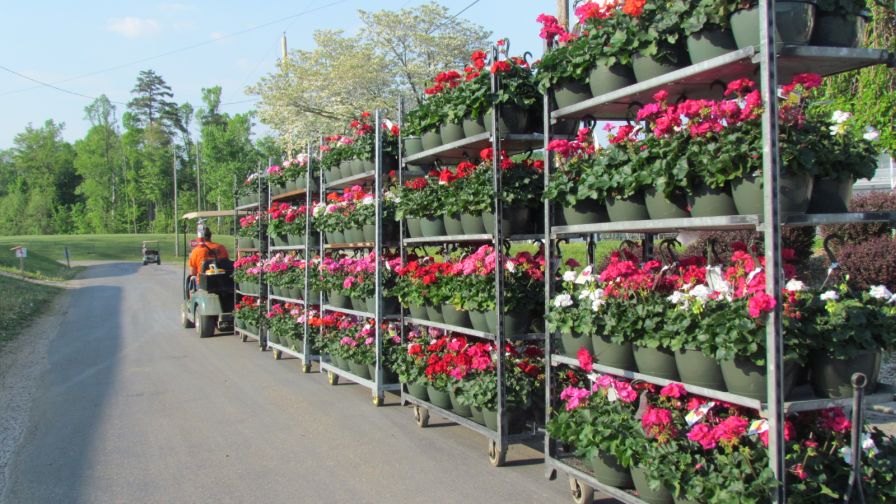
Darrell Norris and Son Greenhouses’ “supermarket system” offers a streamlined approach that accelerates order completion, reduces labor requirements, and eliminates the inefficiencies associated with navigating extensive growing areas for individual item selection. | Tracy Hupp – Darrell Norris and Son Greenhouses
In today’s dynamic business landscape, standing still is akin to falling far behind. For horticulture businesses to truly flourish, a willingness to adapt, embrace transparency, and constantly seek fresh perspectives is paramount. Here’s Part 1 of a look at four forward-thinking growers, plucked from this year’s Top 100 list, who share their strategies for addressing challenges, improving operational efficiency, and boosting their bottom lines.
Stay tuned for Parts 2, 3, and 4.
Supermarket Fulfillment System
Over the past five years, Darrell Norris & Son Greenhouses has implemented a strategic expansion, consistently integrating approximately 100 new transport racks per year to bolster a unique, yet highly efficient, order fulfillment system that keeps pace with the volume of plants it ships.
They call it their “supermarket system,” explains Grower Manager Ryan Norris, the son of founder Darrell Norris.
Darrell Norris & Son Greenhouses operates a sophisticated, vertically integrated growing operation specializing in the production of high-quality bedding plants and seasonal ornamentals. Its Racine, OH-based growing facility is characterized by a commitment to cutting-edge environmental control systems, including advanced climate management software and precision irrigation, which ensure optimal year-round growing conditions.
It serves a broad customer base, including independent garden centers, landscapers, and regional retailers.
This “supermarket system,” Ryan Norris explains, is analogous to a large-scale retail distribution center. It involves a meticulously planned pre-order tally and staging process. Orders are consolidated and staged in a designated dock area, allowing for rapid, bulk order pulling to begin in the morning.
According to Ryan Norris, this streamlined approach significantly accelerates order completion, reduces labor requirements, and eliminates the inefficiencies associated with navigating extensive growing areas for individual item selection.
“We get the orders done very quickly and with less help,” he says. “We’re pulling orders in bulk instead of going around 20 acres and just picking [plant material].”
By centralizing order staging within a dedicated facility, Ryan Norris says they’ve transformed order fulfillment into a highly efficient, stop-and-shop-style operation. Employees retrieve pre-staged items from organized racks, maximizing throughput and minimizing handling time.
“We use a dock area as the planning area, and we call it ‘The Supermarket,’” he says.
“On the end walls is where we stage everything. Then the guys get their lists, and then they go through it shopping just like you’re in a supermarket.”
Founder Darrell, Ryan’s father, first devised the system in the 1980s, but on a considerably smaller scale and much more DIY than what is employed today.
“And it really worked,” he says. “But as we grew, we couldn’t keep up. So, we needed to invest in adding more and more racks. We’re up to 2,000 [racks] now.”
This highly specialized order fulfillment strategy is only partly to credit for their success, Ryan Norris says. A lot of credit goes to their dedicated, task-specific crew system, who must manage an extensive, multi-page order list. Each crew is assigned to a distinct product category — baskets, flats, or pots — ensuring consistent expertise and efficiency in handling specific product types.
A dedicated team member maintains a meticulous tally of daily orders, enabling crews to immediately transition to stocking for the following day upon completion of their current tasks. This structured approach minimizes variability and maximizes throughput by maintaining consistent personnel on specific order types.
To address peak demand periods, such as the intense Mother’s Day rush, when basket and potted plant orders surge dramatically, Ryan Norris says they implemented a dynamic staffing model, strategically deploying additional crews to augment existing teams. This flexible resource allocation ensures seamless order fulfillment.
“It’s just basket after basket going out,” he says. “This ‘supermarket’ system allows us to handle that sort of volume efficiently. And the additional racks we’ve added have been essential for our fulfillment [system] to stay organized.”

